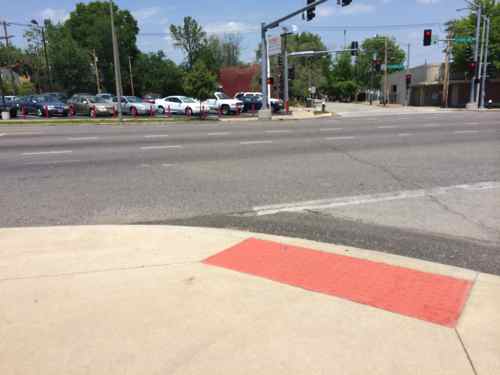Crossing Gravois Ave At McNair Ave
I believe the design of our physical environment plays a role in our decisions, just as other factors, like time & money, might. When the route between point A and B is a pleasant walk, many will opt to walk. But those same people who’ll opt to walk in ideal conditions will decide not to walk if the route isn’t pleasant. I also think the design of our pedestrian network is lagging, motorists would never accept equivalent conditions. For example, crossing Gravois at McNair.
The design says you should cross only on the west side of McNair. Those traveling on the east side of McNair need to use the west side to cross Gravois, per the roadway design. Because of how Gravois cuts through the orthogonal street grid, setting up the proper crossing on the east side would be complicated. With only one side of McNair available as a crossing point you’d think it would be correct.


The button and ramp are supposed to be on the same side…basic common sense. It’s also common sense to stripe a crosswalk to guide pedestrians crossing 8 lanes (6 traffic, 2 parking).

Just don’t blame the City of St. Louis for this, Gravois is a state road maintained by the Missouri Department of Transportation (MoDOT). I accept that crosswalks can’t/shouldn’t be striped at every street that intersects with Gravois, but if pedestrian signals are in place so should a visible crosswalk.
Can you imagine roads designed with so little thought for the users? I can’t. I’ll send a link to this post to MoDOT & city officials to alert them of the problems at this intersection.
— Steve Patterson
I appreciate your search for perfection, but I’ll try and explain why it didn’t happen, here.
Painted crosswalk – costs money to install, costs money to maintain, provides little added “protection” at a signalized intersection – the pedestrian-activated walk signals offer much greater “protection”, extending the cycle so that it’s long enough for a pedestrian to cross the multiple lanes, here. Until we have more money available, I’ll take more ramps and more signals over more paint, any day.
Ramp location – dictated by existing sewer inlet (shown by manhole cover in first photo) – since this is on the “far” side of the intersection, the ramp, as located, won’t be blocked by traffic waiting for a green light (unlike on the “near” side). Moving the sewer inlet, while possible, would make installing the ramp much, much more expensive.
Button location – likely installed before the ramp was – works well for pedestrians who like stepping off a curb (and not stepping into water running along the curb), works less well for wheelchair users, but since “waiting for the light” involves, duh, waiting, pushing the button, then re-positioning to the other side of the pole can be done during the wait time. Could/ should it be moved? Yes. Is it a big priority? Depends on who you ask.
We live in a city with old infrastructure and many streets that don’t follow a grid. Anytime you end up with oblique intersections, especially those involving multi-lane streets, you’re going to end up with situations like this one. People “don’t walk”, here and elsewhere, not because of which side the ramp or the button ended up on, people “don’t walk” because it takes more effort than driving, they get hot and sweaty (this time of year), and the destinations are “too far” apart. A lack of density is the biggest disincentive, not a lack of painted crosswalks and perfect ramp configurations!
I appreciate your input, but I’ll try to explain why this fails to meet the ADA.
1) the button needs to be reachable from the ramp, not the other side of the base!
2) still checking but I’m pretty certain a crosswalk is required at signalized intersections, they are helpful for the visually impaired.
3) The intersection of McNair & Shenandoah just 30 feet to the north has a crosswalk.
Moving the button is the least expensive request you have – I was just trying to guess why it was “wrong” and remains “wrong”.
I agree, a painted crosswalk is a helpful addition. Under the city’s ordinance, a “crosswalk” is presumed to exist at every intersection, with or without paint – http://www.slpl.lib.mo.us/cco/code/data/t1720.htm – but it boils down to dollars – we should paint marked crosswalks at every intersection, but we simply don’t have the money to do so!
Does McNair & Shenandoah have a signal? I think the city takes an either-or position on striped crosswalks – if there’s a signal, rarely do they do a painted crosswalk; if there’s an intersection that is highly used (as in close proximity to a school) but has no signal, a painted crosswalk is warranted.
slightly related: http://youtu.be/ldDpdjiZ2-c